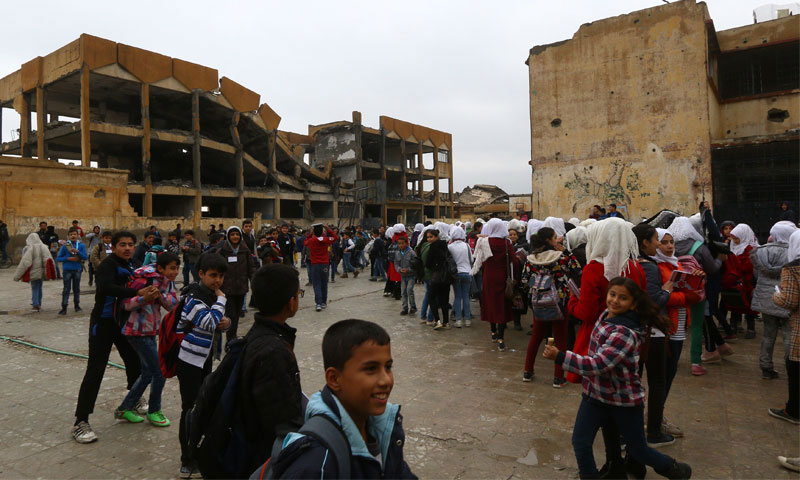Schools have opened in Syria at the beginning of September to receive students in their new school year. However, more than half of Raqqa’s children have not yet had the chance to have access to these schools, amid the devastation, poverty, and fear prevailing their lives in the capital of “ISIS caliphate,” which has witnessed the most severe violations in the years of the Syrian conflict.
There are no accurate statistics on the numbers of students in the city that has been stripped of its records and deprived of its means, said Raqqa Civil Council Adviser, Abdullah al-Arian to Enab Baladi. However, 50 to 60 percent of the children are still outside the schools that operate under unendurable pressure.
Raqqa is still drowning in rubble after two years of control by ISIS.
Integrated system in which childhood is lost
The majority of children over the age of 10 do not enroll in schools, as they are forced to enter the labor market, and some of them cannot afford to buy school uniforms or supplies due to the extent of poverty prevailing in the city, according to the Adviser.
The United Nations estimates that 470,000 people are needy in Raqqa Governorate, 47% of whom are in urgent need of help, including more than 235,000 children and about 5,000 teachers who are in need of educational assistance.
All schools were closed in early 2014, after ISIS’s control over the city in April 2013. The schools were only able to resume their work after ISIS’s forces left the city in October 2017.
44 percent of schools have suffered damage and destruction, and only half of children aged 6 to 12 and 12 percent of children aged 13 to 17 are receiving education, according to a report published by the UN REACH initiative in March.
85 percent of children deprived of school were compelled to enter the labor market, and 41 percent suffered from health problems that prevented them from going to school.
88 percent of schools are suffering from severe shortages of school equipment, and 61 percent lack educational materials and teachers.
No teacher has graduated from Raqqa since 2012, said Abdullah al-Arian. Huge number of former teachers no longer practiced their job, fearing disciplinary action the Syrian government may take. Others were already retired, dead or displaced, while the rest were subject to military service to date.
“The issue is not only about getting the child to be admitted to school. If there is no electricity for him to study at night, he will not be able to do his/her homework. If a father cannot provide his child with good food, his mind and body will not be able to grow and he will not be able to pursue his education. It is a whole integrated system, ” said al-Arian.
Needs are “bigger” than achievements
Raqqa Civil Council inaugurated dozens of schools, which were repaired using the minimum resources, after the end of the school year yet many schools were lacking windows or doors. However, al-Arian said that “what is required is much more.”
Raqqa suffered devastation after five months of the US-led coalition forces’ continuous bombing during the campaign waged against ISIS, carrying out 6,039 airstrikes between June and November 2017.
However, the Civil Council, which is administratively affiliated to the Kurdish Autonomous Administration, has rehabilitated 322 schools over the past two years and is working to rehabilitate an additional number of 21 schools this year, said the Deputy Chairman of the council’s education committee, Yousuf Mohammad to Enab Baladi.
Around 108 thousand students managed to receive education during the past year in the governorate of Raqqa. The committee estimates the number of students this year to be more than 130 thousand.
A third of the total number of schools across Syria has been damaged or destroyed, according to UN estimates, with many of the remaining schools being used by the displaced as shelters, and more than a third of school-age children, accounting for 2.1 million, being deprived of education.

